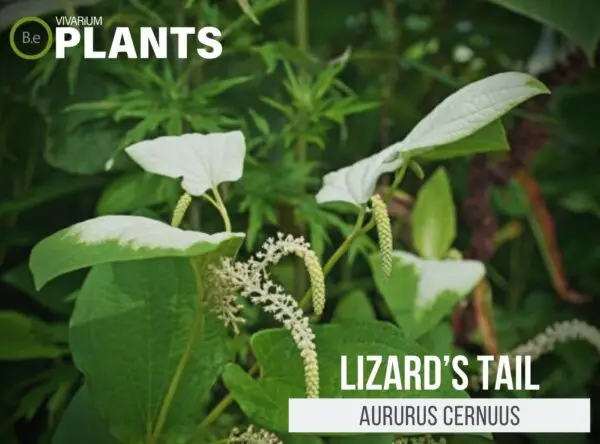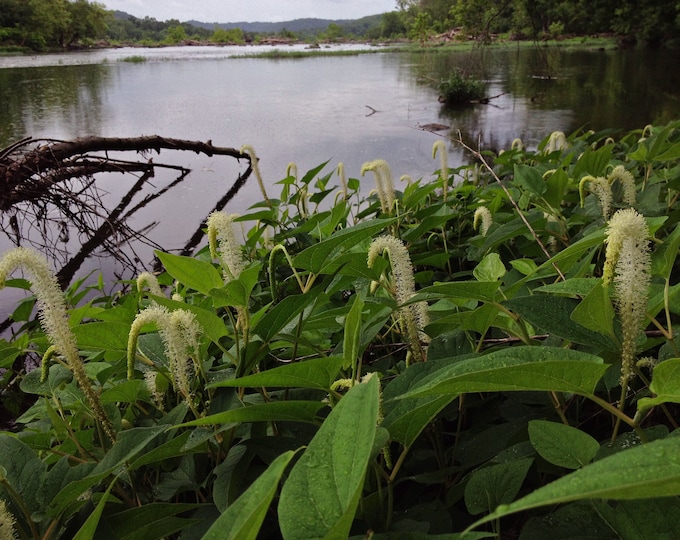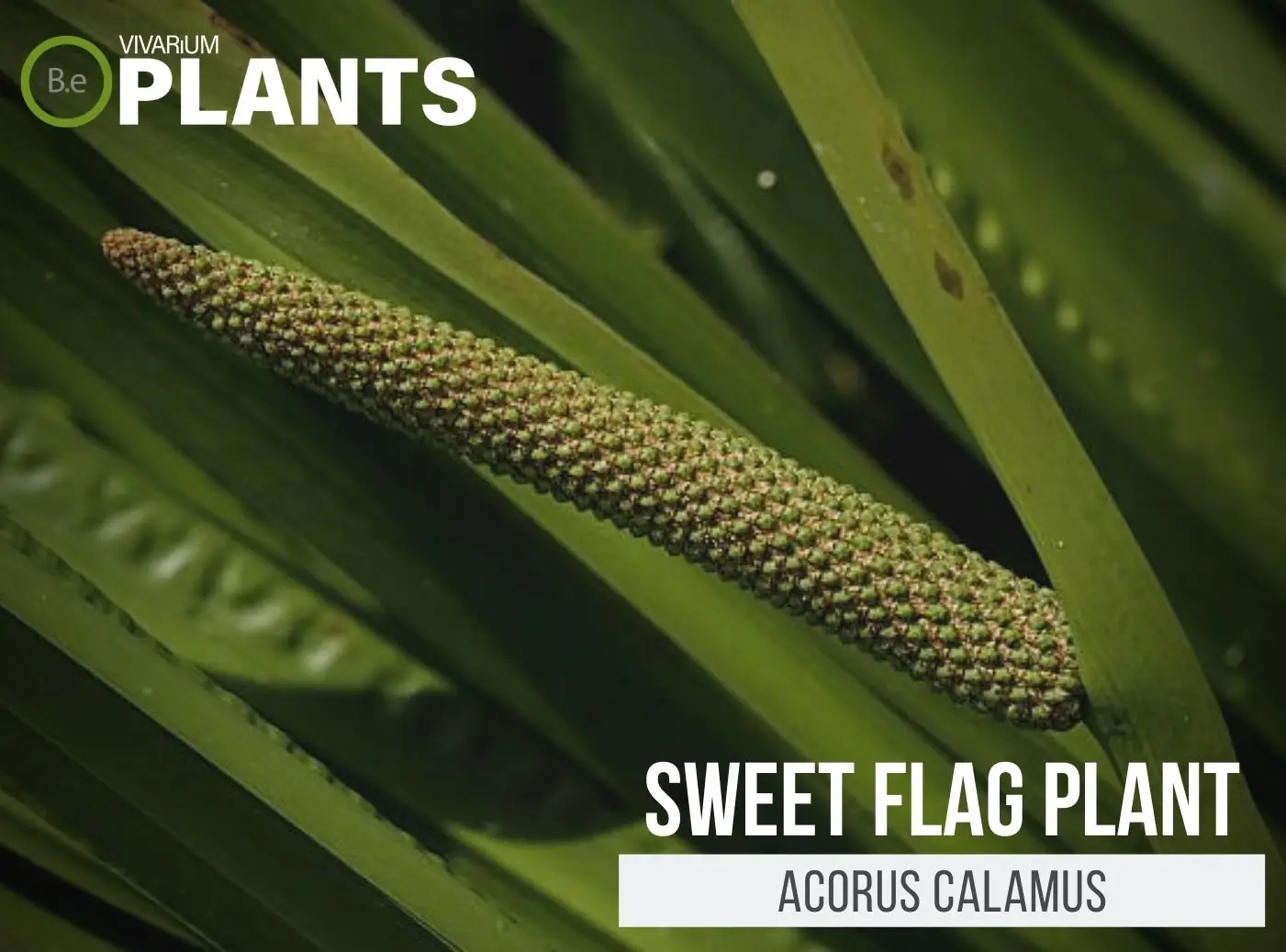Saururus cernuus, also known as Lizard’s Tail, is a stunning pond plant for the vivarium, making it the perfect fit for a variety of enclosures.
Its star-shaped leaves, grass-like texture, and ability to tolerate a relatively wide pH range are just a few of its benefits.
Plus, it’s one of the easier plants to care for as a beginner or intermediate vivarium keeper.
| Quick Stats: | |
|---|---|
| Scientific Name | Saururus cernuus |
| Common Name | Lizard’s Tail |
| Family Name | Saururaceae |
| Habitat | Shallow waters |
| Temperature | 75°F to 85°F |
| Height | 8 – 12 inches |
| pH | 4.5 – 7.5 |
| Lighting | Moderate |
What Is Saururus Cernuus?
Saururus Cernuus is a perennial semi-aquatic herb that is native to diverse areas of North America.
It has a grass-like texture and typically grows in a clump formation with bright green, glossy leaves.
Each pointed leaf has a distinctive star shape with more than four angular lobes.
In some cases, it produces a white flower, which is occasionally an aster-like pop.


Saururus Cernuus Facts
This plant is commonly referred to as the African Lily, Elephant’s Ear, or even for its resemblance to a lizard’s tail.
It does well in many temperature environments, and it is also resistant to common fungal and bacterial infections.
Though it is a slow-grower, once it has fully matured, it makes a beautiful background plant and is also a great hideaway for smaller creatures.
Description
Saururus cernuus has foliage that is widely varied in texture and form.
The individual leaves have a glossy texture, and they individually have star-shaped points.
Each leaf is also highly textured and can range from light to dark green.
The stems of the plant can reach a maximum height of around 12 inches tall and the plant itself has a rounded shape when mature.
Habitat
Saururus cernuus is native to the wetlands, swamps, and shallow waters all across North America and some parts of Asia and Europe.
It is not as common to find as it once was due to the destruction of its natural habitat but it can still be found in some wetland areas.
The temperatures associated with its native habitats for this plant range from the upper 70s to the lower 80s.
pH Preference
Saururus cernuus is quite adaptable when it comes to potential hydrogen levels.
This plant can thrive from pH acidic conditions to neutral, meaning it can take on a greater range than most other plants.
The ideal pH range for this plant is 4.5 to 7.5, making it a good choice for many terrariums builds.
Vivarium Type
Saururus Cernuus is quite an easy-going species.
With that in mind, it will not be too complicated when choosing the type of enclosure it is grown in.
It is best to try and replicate the plant’s natural habitat as much as possible.
Doing so will make it easier to provide this foliage plant with its basic needs.
The proper setup and theme of the enclosure will make a big difference to the overall look and health of the plant.
Be sure to choose setups that are moist and high in humidity.
Here are recommended vivariums it will do well in:
- Paludariums – Half aquatic/ half terrain-based enclosure.
- Terrariums – Fully terrain-based enclosures with little to no aquatic features.
- Ripariums – Mostly aquatic-based enclosures with some terrain features present.
Vivarium Placement
Saururus cernuus can tolerate a wide variety of mediums and substrates, but it is best suited for those that are damp and well-draining.
It prefers to be placed in the background of a gradually decreasing vivarium and is an excellent choice for those trying to mimic an aquatic environment.
Substrate
When planting Saururus cernuus in a vivarium, it’s best to use a damp substrate like aquatic gravel or sand.
There should also be a peaty soil-like layer underneath the substrate for it to absorb moisture better.
As for the substrate’s pH level, it can range from acidic to neutral and be any texture from rocky substrates to finer sand substrates.
Lighting
This plant prefers partial to full shade, meaning it does best with moderate levels of light.
Direct sunlight should be avoided since it can eventually cause wilting of the plant.
LED aquarium lighting is an ideal option for providing the right amount of light with the right type of spectrum.
Buy Saururus Cernuus
When buying Saururus Cernuus, there are a few things to keep in mind.
Making sure the plant is healthy when purchased is essential for its success in a vivarium or pond.
Vegetation that is already in poor conditions will have a very hard time adjusting to new environments.
Click the image below to learn more about the current price and other relative info about this plant.
Saururus Cernuus Care & Propagation
Saururus cernuus is not particularly difficult to take care of as long as it has the right amount of light and moisture in its enclosure.
This plant can be propagated through the division of portions of the clump or by planting seeds in the container.
The growth rate of this plant is moderate, so it may take some time to develop its full size.
How To Grow
When growing the Saururus cernuus, it is essential to make sure that the plants are being watered with a balanced pH of water.
Those who wish to grow this plant from seeds should wait for the seeds to mature before planting them in proper containers.
Once the seeds are planted, water them repeatedly until there is sufficient progress in growth.
Watering
The ideal watering frequency for the Saururus cernuus is to water it at least once a week or whenever the leaves or roots of the plant are starting to dry out.
The amount of water required will also depend on the size of the container, so it is essential that this be taken into consideration.
A misting or fogger system can also be used to ensure more even and consistent humidity levels.
Plants Similar To Saururus Cernuus
Adding diversity to an enclosure is key to an aesthetically pleasing setup.
Try mixing up the look of your vivarium with different flora that can easily co-exist in the same types of environment.
Furthermore, if for some reason you find Saururus cernuus hard to acquire or would like to consider something similar to this aquarium plant…
Here are other stem plants you might find will do well with or in place of Lizard’s Tail:
Conclusion
Saururus cernuus is an attractive and easy-to-care-for pond plant that is ideal for a variety of vivariums.
As a background plant, it can provide an extra dimension to the enclosure.
With regular watering, it shouldn’t take long for this plant to become established in its container.
It’s also great for those who want to mimic a semi-aquatic habitat as it tolerates a wide range of pH levels.
Overall, this plant is a great choice for those just starting out in plant keeping.
Frequently Asked Questions
Yes, Saururus cernuus (lizard‘s tail) is an invasive species in some areas, particularly in the eastern United States. It can rapidly out–compete native wetland species and overcrowd wetland habitats, leading it to be classified as an invasive aquatic weed.
The lizard‘s tail plant is used in traditional medicinal practices to treat a variety of ailments such as fever, stomach ache, headache and respiratory illnesses. It is also used as a diuretic, to stop bleeding and as an anti–inflammatory.
Yes, the tail of Saururus cernuus, or lizard‘s tail, is edible. It is a common edible plant among Indigenous peoples and herbalists, with its leaves and stems used in various recipes. Lizard‘s tail is also known for its bitter taste and can be made into a tea or dried and ground into a powder form.




